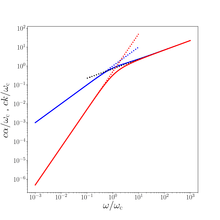Stokes's law of sound attenuation
Stokes's law of sound attenuation is a formula for the attenuation of sound in a Newtonian fluid, such as water or air, due to the fluid's viscosity. It states that the amplitude of a plane wave decreases exponentially with distance traveled, at a rate given by
where is the dynamic viscosity coefficient of the fluid, is the sound's angular frequency, is the fluid density, and is the speed of sound in the medium:[1]
The law and its derivation were published in 1845 by physicist G. G. Stokes, who also developed the well-known Stokes's law for the friction force in fluid motion.
Interpretation
Stokes's law applies to sound propagation in an isotropic and homogeneous Newtonian medium. Consider a plane sinusoidal pressure wave that has amplitude at some point. After traveling a distance from that point, its amplitude will be
The parameter is dimensionally the reciprocal of length. In the International System of Units (SI), it is expressed in neper per meter or simply reciprocal of meter (). That is, if , the wave's amplitude decreases by a factor of for each meter traveled.
Importance of volume viscosity
The law is amended to include a contribution by the volume viscosity :
The volume viscosity coefficient is relevant when the fluid's compressibility cannot be ignored, such as in the case of ultrasound in water.[2][3][4][5] The volume viscosity of water at 15 C is 3.09 centipoise.[6]
Modification for very high frequencies

Stokes's law is actually an asymptotic approximation for low frequencies of a more general formula:
where the relaxation time is given by:
The relaxation time for water is about (one picosecond per radian), corresponding to a linear frequency of about 70 GHz. Thus Stokes's law is adequate for most practical situations.
References
- Stokes, G.G. "On the theories of the internal friction in fluids in motion, and of the equilibrium and motion of elastic solids", Transactions of the Cambridge Philosophical Society, vol.8, 22, pp. 287-342 (1845
- Happel, J. and Brenner , H. "Low Reynolds number hydrodynamics", Prentice-Hall, (1965)
- Landau, L.D. and Lifshitz, E.M. "Fluid mechanics", Pergamon Press,(1959)
- Morse, P.M. and Ingard, K.U. "Theoretical Acoustics", Princeton University Press(1986)
- Dukhin, A.S. and Goetz, P.J. "Characterization of liquids, nano- and micro- particulates and porous bodies using Ultrasound", Edition 3, Elsevier, (2017)
- Litovitz, T.A. and Davis, C.M. In "Physical Acoustics", Ed. W.P.Mason, vol. 2, chapter 5, Academic Press, NY, (1964)